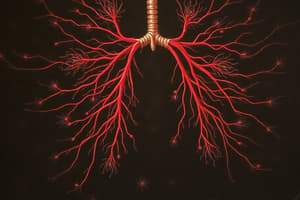Podcast
Questions and Answers
What are the characteristics of the anaerobic energy system?
What are the characteristics of the anaerobic energy system?
Dominant under high intensity training and low duration.
What is the ATP PC System?
What is the ATP PC System?
The system by which the body fuels 10 to 20 seconds of intense exercise using stored ATP and phosphocreatine.
What is the fuel source during ATP PC?
What is the fuel source during ATP PC?
Phosphocreatine (Creatine-Phosphate).
What is Phosphocreatine?
What is Phosphocreatine?
What enzyme is controlled during ATP PC?
What enzyme is controlled during ATP PC?
What is Creatine Kinase?
What is Creatine Kinase?
What is the function of creatine?
What is the function of creatine?
What happens to creatine after it is used?
What happens to creatine after it is used?
When is ATP gained?
When is ATP gained?
What is Glycolysis?
What is Glycolysis?
What is Pyruvate?
What is Pyruvate?
After Glycolysis, how much pyruvate is available?
After Glycolysis, how much pyruvate is available?
What happens to pyruvate after glycolysis?
What happens to pyruvate after glycolysis?
What happens when substrates must be replenished if O2 is not available?
What happens when substrates must be replenished if O2 is not available?
What is Fermentation?
What is Fermentation?
What does fermentation produce?
What does fermentation produce?
Match the following terms with their definitions:
Match the following terms with their definitions:
Flashcards are hidden until you start studying
Study Notes
Anaerobic Energy Systems Overview
- Dominates in high-intensity, low-duration exercise.
- All energy systems function simultaneously, with anaerobic being predominant during intense efforts.
ATP PC System
- Fuels intense exercise lasting 10 to 20 seconds.
- Utilizes stored ATP and phosphocreatine to support muscle contractions.
Fuel Source in ATP PC
- Phosphocreatine (Creatine-Phosphate) is the primary fuel source.
Phosphocreatine
- A phosphorylated creatine molecule aiding in ATP recycling.
- Essential for maintaining energy levels in skeletal muscle and the brain.
Creatine Kinase Enzyme
- Controls the ATP PC system.
- Catalyzes the reaction converting creatine and ATP into phosphocreatine and ADP; reversible for ATP production.
Function of Creatine
- Acts as a phosphate reservoir.
- Transferring phosphate to ADP helps replenish ATP stores after use.
Creatine Replenishment
- After use, creatine is rephosphorylated to restore phosphocreatine.
- The rephosphorylation process requires energy.
ATP Production
- Gained aerobically through anabolic processes.
Glycolysis
- Converts glucose (C6H12O6) into pyruvate.
- Energy released is used to form ATP and NADH.
Pyruvate
- End product of glycolysis, converted to acetyl coA in the presence of oxygen.
- Anaerobic conditions lead to lactate production instead.
Pyruvate Availability
- Significant amounts of pyruvate remain due to carbon chain splitting during glycolysis.
Post-Glycolysis Processes
- With oxygen (O2): aerobic oxidation occurs.
- Without oxygen (O2): glycolysis continues, leading to pyruvate accumulation.
Substrate Replenishment under Anaerobic Conditions
- Fermentation occurs to replenish substrates, leading to lactate buildup.
Fermentation
- Rapid breathing post-activity helps convert lactic acid back to pyruvate.
- High lactate levels can cause muscle pain and fatigue.
Fermentation Byproducts
- Produces lactate and ATP.
Lactate Formation
- Lactate production generates H+ ions influencing ATP hydrolysis.
- Aerobic conditions allow the body to buffer pH effectively to prevent muscle acidosis.
Muscle Acidosis
- Result of inadequate clearance of lactic acid, leading to metabolic acidosis.
- Lactate is typically cleared from the bloodstream by liver, kidney, and skeletal muscle.
Studying That Suits You
Use AI to generate personalized quizzes and flashcards to suit your learning preferences.




